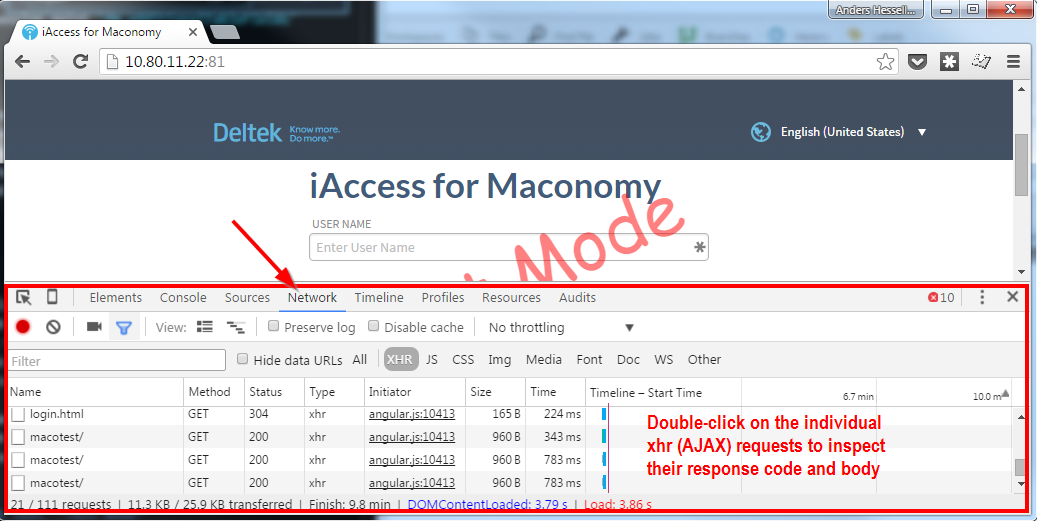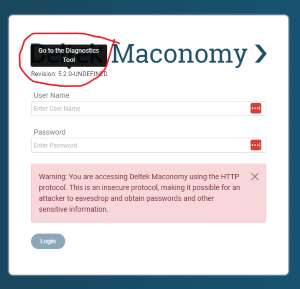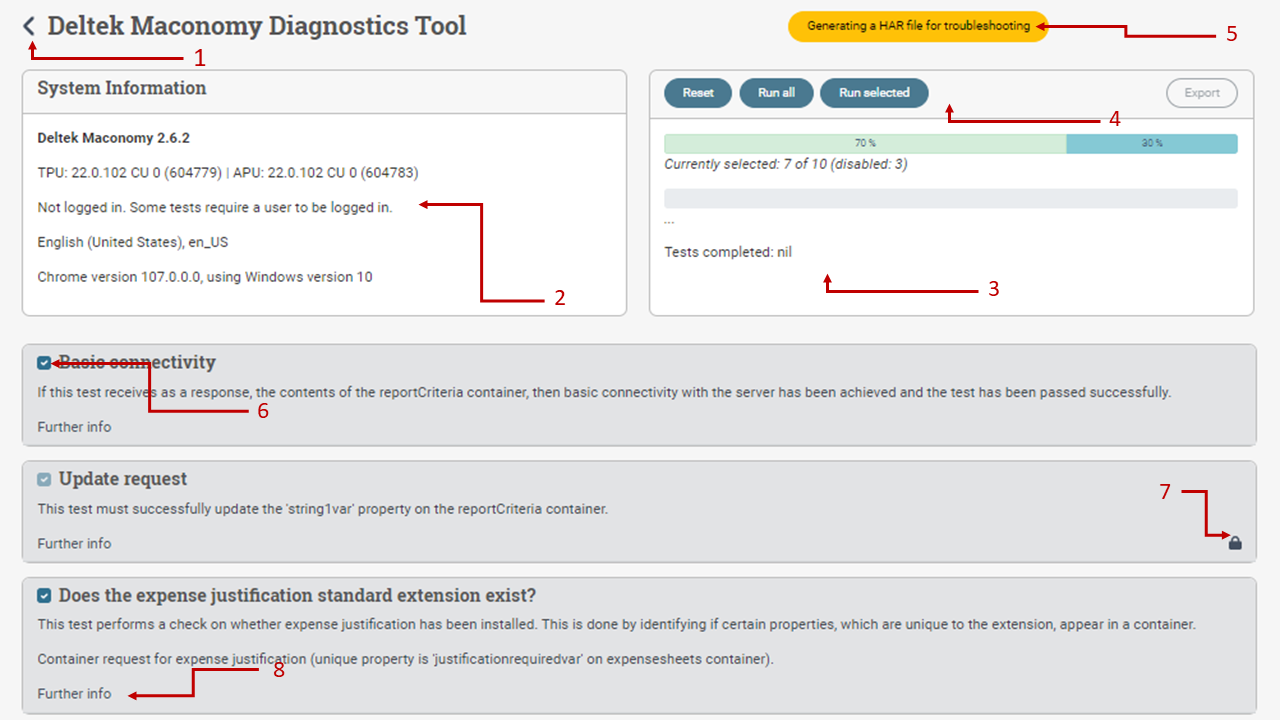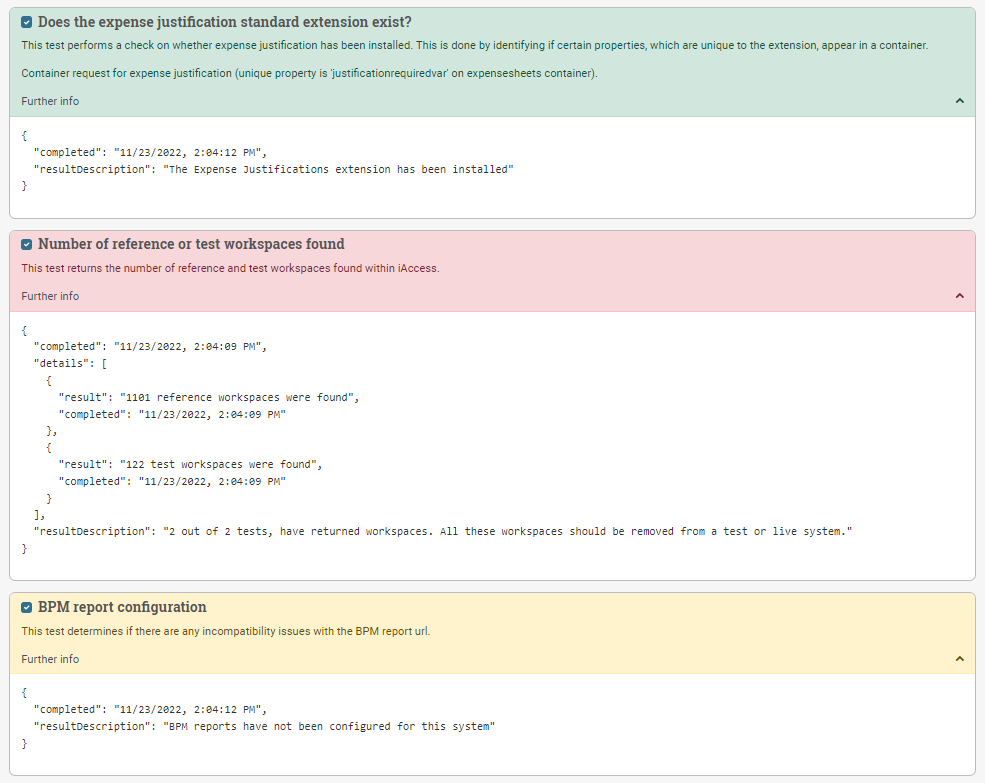Solutions to common installation issues are found in the Installation section. If your issue/problem is not listed there, the following section provides some additional clues to solve common issues. If you still cannot find a solution to your specific problem, please start a conversation in our UI-Web Client (iAccess) channel under the Maconomy Knowledge Center team in Microsoft Teams. You can also opt to raise a support case through Customer Care to get your concrete issue resolved.
Tip: The Browser Developer Tools
A piece of general advice for technical consultants: Always take a look at the requests that the browser issues when you are getting installation and/or network problems. In particular, the AJAX requests and error responses are often useful for uncovering installation and configuration errors. The firgure below shows Developer Tools in Chrome where the Network Tab can be a very powerful tool to uncover installation and network problems.

"Incompatible API versions..."-Error
The iAccess specification format deployed on the Maconomy server is not compatible with the installed version of iAccess. This error usually occurs because either the application.json specification or the iAccess installed on a given web server have not been updated as part of a system upgrade. If the lowest number in the error message is the required API version, then you need to upgrade the iAccess version installed on the given web server. This requires the use of MConfig.
If the lowest number is the loaded specification API version, then update the specification deployed to the Maconomy server. This requires the Maconomy Extender.
"Bad Request: Unable to connect to 'configurations' endpoint..."-Error
When moving from version 1.1.x to 1.2.x, iAccess becomes dependent on a new webservice called configurations. This web service has to be available through the proxy configuration on the web server. This is similar to how the containers and filedrop web services are setup. See the Installation section for details.
Even if you have properly configured the configurations endpoint, you may still get the error on certain IIS installations. The problem can then be that some IIS installations do not allow the colon : character in URLs. To solve this, allow the colon : in the web.config file in the root of your web server [@IISColons]. Use its unicode encoded format %u003a in the configuration.
<configuration>
<system.web>
<!-- Default <,>,*,%,&,:,\,?
or %u003c,%u003e,%u002a,%u0025,%u0026,%u003a,%u005c,%u003f -->
<httpRuntime
requestPathInvalidCharacters="%u003c,%u003e,%u002a,%u0025,%u0026,%u005c,%u003f" />
</system.web>
<system.webServer>
...
</system.webServer>
</configuration>
"A%20Network%20Error%20Occurred"-Window Opens
This error occurs when HTTPS has been partially or incorrectly configured on the web server. Double-check that the web server is configured according to the steps in the Installation section. This includes checking that the OSGi products in MConfig are configured correctly, and that HTTPS forwarding rules are set up on the web server.
Error 500 in the Browser on Apache 2.2 Installations
If you get a 500 error code in the browser and the following message in the Apache error log: configuration error: couldn't perform authentication. AuthType not set!: /, the cause is an incorrect vhosts.conf file. Specifically, make sure that the line Require all granted is not present. This problem occurs for Apache 2.2 only. Apache 2.4 requires this line.
Diagnostics Tool
This is a suite of tests that you can run from a web browser and which you can use to debug various basic properties of the web client such as basic network connectivity, file upload size limits, update permissions, and so on. These tests can prove useful in debugging ongoing issues and/or, from an installation point of view, checking that the system has been configured correctly. Each test provides 'further information', explaining why a test may have failed and what the possible solutions are.
Access
You can use the tool without logging in, but tests requiring authentication will be disabled unless you log in.
You can access the tool using either of the following methods:
In the web client URL, replace the part which begins with '/workspace/....' with '/debugger'. The updated URL will take you to the tool. For example: 'http://myHostName:5555/debugger'
From the web client login screen, hold down the CTRL+SHIFT keys and move your cursor underneath the Deltek Maconomy heading. The web client will display the revision number as a hyperlink which will take you to the Diagnostics tool.

Functionalty

The key panels and buttons are:
< - This hyperlink takes you back to the web client.
System Information panel - This builds system information on the Maconomy version, user details, language and locale, browser version, and so on. This panel serves as a summary. To obtain further information, you will need to export the results.
Status panel - This displays information on the number of tests you selected, and the results after you run the tests (number of errors, warnings, and passes).
Reset, Run all, Run selected - Use these three buttons to run all the tests, run a selection of tests, or reset the system (which clears the results of the previous test run). After you run tests, the Export button is enabled; click this button to download a .json file containing the tests' results as well as system information.
Generating a HAR file for troubleshooting - This hyperlink takes you to a page with information on how to generate a .har file. This is useful for dealing with debugging issues.
Under the System Information and Status panels, the tool lists the tests. Each test is enclosed in a box which includes the following:
A checkbox for selecting or deselecting the test - Select each test that you want to run, then click the Run selected button to run only these tests. If the checkbox is disabled for any test listed, this means you will need to log in before you can run that test.
Lock icon - This indicates that you are not logged in and therefore cannot run that test. Click the icon to go to the login screen. After you log in, you can then go back to the Diagnostics tool to run the test.
Further info - Click this hyperlink to go to a web page that contains an explanation of the test as well as solutions for any errors or issues discovered after running the test.
Test Results
The tool color codes tests that are run and completed.
- Green - success
- Red - error
- Amber - warning
To view the results for each test, click the chevron on the bottom right corner of the test box. A successful or warning result will include a helpful description of the result; an error will include the actual error object received back by the failed test.

Exporting Test Results
Click the Export button to download results and system information as a .json file. To aid customer care in resolving any issues, attach this .json file and the relevant .har file to your support ticket or email.
Available Tests
The following table gives an overview of the tests currently available. We hope to add more tests in the future.
| Test | Description | Login required | ||
|---|---|---|---|---|
| Basic connectivity | If this test receives the contents of the reportCriteria container as a response, then basic connectivity with the server has been achieved and the test has been passed successfully. | false | ||
| Update request | This test must successfully update the 'string1var' property on the reportCriteria container. | true | ||
| Does the expense justification standard extension exist? | This test performs a check on whether expense justification has been installed. This is done by identifying if certain properties (which are unique to the extension) appear in a container. | false | ||
| Number of reference or test workspaces found | This test returns the number of reference and test workspaces found within the web client. | false | ||
| BPM report configuration | This test determines if there are any incompatibility issues with the BPM report URL. | true | ||
| WOFF file MIME type test | This test determines whether MIME types have been configured correctly, by testing if a WOFF file can be served. | false | ||
| File upload size limit | This test determines the maximum permissable file size which can be uploaded via the web client. | false | ||
| Diagnostics Web Service Paths test | This test verifies whether certain paths are being handled correctly by the reverse proxy. | false | ||
| Diagnostics Web Service Timings test | This test displays an ISO-8601 representation of the amount of time it takes a request to enter and exit the Coupling Service. An average duration for ten requests is returned. | false | ||
| Diagnostics Web Service Cookies test | This test verifies whether cookies are transmitted correctly back and forth through the reverse proxy. | false |
